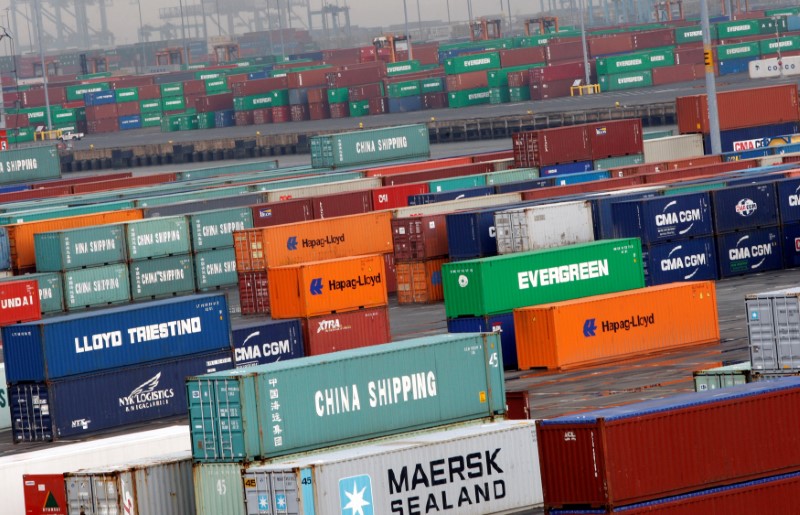By Lucia Mutikani
WASHINGTON (Reuters) - The U.S. trade deficit increased to a more than nine-year high in January, with the shortfall with China widening sharply, suggesting that President Donald Trump's "America First" trade policies aimed at eradicating the deficit will likely fail.
The trade gap continues to widen a year into the Trump presidency. Trump, who claims that the United States is being taken advantage of by its trading partners, has imposed tariffs on imports of some goods and threatened punitive measures on others to shield domestic industries from competition. The protectionist measures have sparked fears of a trade war.
"Trump's economics team is trying to turn back the clock on trade, but we doubt they will succeed as they are interfering with the business decisions made by thousands of American companies over the years," said Chris Rupkey, chief economist at MUFG in New York. "This is a trade war with ourselves."
The United States has been running trade deficits for decades, with the trend worsening over the last 30 years as companies shifted manufacturing to countries like China.
The Commerce Department said on Wednesday the trade deficit jumped 5.0 percent to $56.6 billion. That was the highest level since October 2008 and exceeded economists' expectations of an increase to $55.1 billion. Part of the rise in the trade gap in January reflected higher commodity prices.
The politically sensitive goods trade deficit with China surged 16.7 percent to $36.0 billion, the highest since September 2015. The deficit with Canada soared 65 percent to a three-year high of $3.6 billion. China and Canada are the United States' top trading partners.
Trump in late January imposed broad tariffs on imported solar panels and large washing machines. Last week, Trump announced he would slap import tariffs of 25 percent on steel and 10 percent on aluminum to protect domestic producers.
While these actions may prove politically popular with Trump's working class political base, especially in states hard-hit by factory closures and import competition, analysts warn they could undercut economic growth.
There are fears that the tariffs could jeopardize talks on the North American Free Trade Agreement (NAFTA) linking Canada, Mexico and the United States. Trump ordered a renegotiation of the trade pact to offer terms more favorable to Washington.
Worries of a trade war were heightened on Tuesday by the resignation of Gary Cohn, Trump's top economic advisor, spooking financial markets. Stocks on Wall Street were trading lower while prices for U.S. government bonds rose, attracting safe-haven bids. The dollar rose versus a basket of currencies.
FULL EMPLOYMENT
Trump's "America First" trade policies are part of an attempt to boost annual economic growth to 3 percent on a sustainable basis. The government in January slashed corporate and individual income taxes.
But with the economy almost at full employment, the increase in demand spurred by the $1.5 trillion tax package will probably be satisfied with imports, further worsening the trade deficit.
The economy's strong fundamentals were underscored by a separate report on Wednesday from ADP Research Institute showing private employers added 235,000 jobs in February.
The report, which is jointly developed with Moody's Analytics, was published ahead of the government's more comprehensive employment data on Friday.
According to a Reuters survey of economists, nonfarm payrolls probably increased by 200,000 jobs last month, matching January's gains. The unemployment rate is forecast falling one-tenth of a percentage point to 4.0 percent, which would be the lowest level since December 2000.
The surge in the January trade deficit was flagged by an advance goods trade deficit report last week. When adjusted for inflation, the trade deficit increased to $69.7 billion from $68.5 billion in December.
The so-called real trade deficit is above the fourth-quarter average of $66.8 billion. This suggests trade would subtract from first-quarter gross domestic product unless the deficit shrinks in February and March. Trade sliced 1.13 percentage points from fourth-quarter GDP growth.
"Strong growth in U.S. domestic demand should continue to pull in non-petroleum imports going forward," said Jay Bryson, global economist at Wells Fargo (NYSE:WFC) Securities in Charlotte, North Carolina. "Net exports likely will exert another significant drag on overall GDP growth in the first quarter."
The economy grew at a 2.5 percent annualized rate in the fourth quarter. Growth estimates for the first quarter are around a 2.0 percent pace.
In January, exports fell 1.3 percent to $200.9 billion, weighed down by a $1.8 billion drop in civilian aircraft. Crude oil exports also declined. But exports of consumer goods rose to a record high and those of motor vehicles, parts and engines were the highest since July 2014.
Exports to China tumbled 28.1 percent. Imports were unchanged at $257.5 billion in January amid a $1.3 billion drop in cellphone imports as well as a $0.9 billion decrease in civilian aircraft. Crude oil imports increased by $2.2 billion, reflecting higher prices. Imports from China rose 2.9 percent.
A third report from the Labor Department showed worker productivity flat in the fourth quarter instead of declining at a 0.1 percent rate as reported last month. Sluggish productivity could make it difficult for the Trump administration to achieve its 3 percent growth target.

Annual economic growth has not surpassed 3 percent since 2005. Gross domestic product expanded 2.3 percent in 2017.